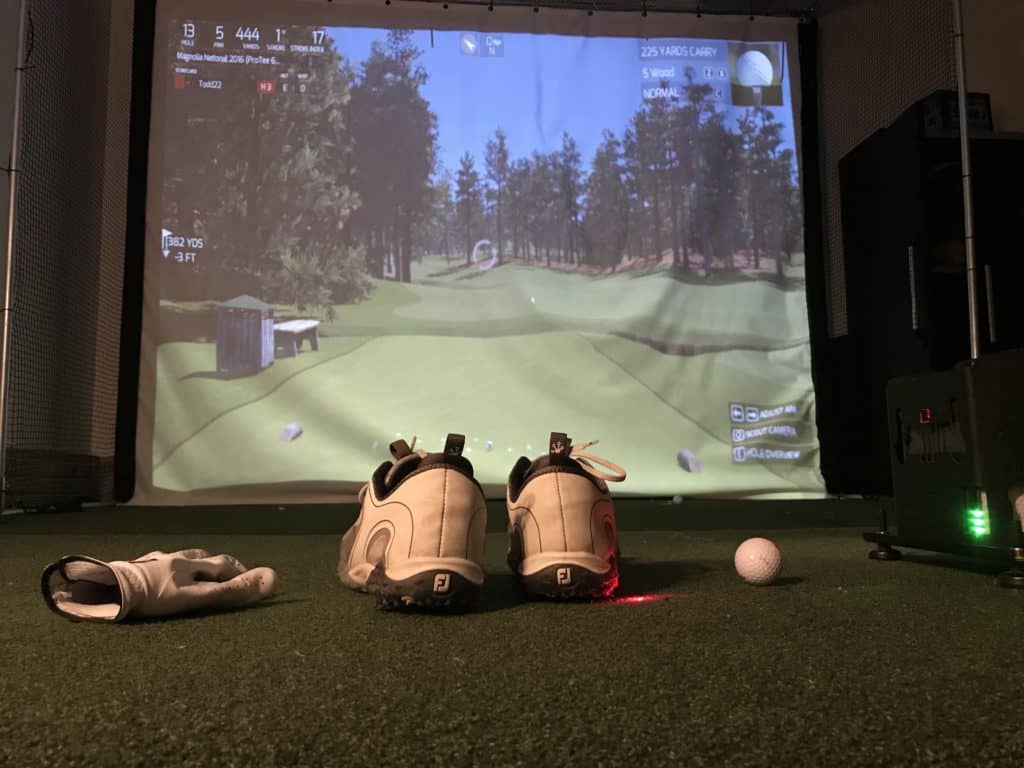Take your game to the next level with more birdies:
- Take Advantage of the Par 5s
- Hit Your Driver Further
- Practice those 10-20 footers
- Keep the Ball Below the Hole
- Get Really Good Inside of 100 Yards
There are few things in golf better than making a birdie!
Yes, you can make an eagle and maybe a hole in one, but realistically making some birdies during each round of golf is feasible once you start striking the ball at a certain level.
We understand that golf can be difficult and par might seem difficult enough, but there are certain places in each round where even the average golfer might be able to leave the hole with a birdie and have a major boost to their overall score that round!
Below, I will dive into 5 tips to help you make more birdies. It is a combination of course strategy and swing training that can help you get your game to the level where you are expecting and then averaging 2-3 birdies per round!

How To Make More Birdies: Top 5 Tips!
Update: This past July I averaged 4.0 birdies per round, up from 2.0 birdies earlier that summer and 1.5 in the previous season! What was the difference? I hit my driver further and straighter than ever and stuck wedges from the 80-105 yard range. I was dialed in and had plenty of birdie putts under 10 feet! This would connect with tips #2 and #5 below! Enjoy your journey!
Tip #1: Take Advantage of the Par 5s
Most par 5s are designed as holes that have a risk and reward element to it. If you are able to hit your driver far enough out there off the tee, you are often left with the decision of whether or not to go for the green in two. The course designer might have put a perfectly placed water hazard or bunker to try to make the shot more difficult and leave with the big rewards of a two putt birdie if you are able to pull the shot off!
This all starts with the willingness to be aggressive on the tee shot than the next shot that for most golfers might be in the 200 to 250 yard range on that second shot. Getting anything inside of 30 feet to the hole would be better than the PGA Tour average, so while it might happen, make sure your expectations are realistic.
Even if you miss the green and have a safe, yet aggressive approach, you might be left with a simple chip or pitch shot that you can get inside of 10 feet. The benefits of being aggressive on the 2nd shot into the par 5 can pay off, especially if you are a good bunker player or have a high level of skill in getting the ball up and down in 2 shots from the greenside area.
The analytics are clear in that the shorter the approach shot is from the hole, the closer the ball will be to the hole after the shot. The 30 yard pitch on average is going to be closer than the 80 yard wedge shot.
Another option is to lay back to a yardage that you are comfortable with. Maybe 80 yards is your range that you feel you can hit the ball inside of 10-15 feet at least 50% of the tie. Over the course of a round of golf, if you manage the typical 4 holes that are par 5s, you can have at least two putts inside of 15 feet.
While the make percentage will be less than 50%, over time you will make some birdies. The approach to lay back to the 80 yard distance or something in that range might be a great option if you really struggle with those delicate chip and pitch shots.
The best players on par 5s are usually the long hitters or those that are great wedge players who can putt. The two putt birdie is a gift and if you hit the ball long enough, you have 4 great opportunities during a round to make a birdie on the 4 par 5s! Which leads us to the next tip!
Resource: How to break 80 in golf (practical guide)

Tip #2: Hit Your Driver Further
I know what you might be thinking! “Yes, we understand, but that is easier said than done!” I might have felt that way for a number of years until I came across the SuperSpeed Golf System. This overspeed based system and protocols is based on the science of swinging a club that is lighter at a faster speed than you swing your driver. When you buy SuperSpeed, you are sent three swing training clubs that are all of different weights. Two of the clubs are lighter than the average driver and one is heavier.
A golfer can expect to see results as early as the first training sessions with speed gains of 5-8% in swing speed early on! These gains become more permanent the longer you train with more increases coming, but at a slower rate.
Check current pricing on SuperSpeed Golf here!
The golfer spends about 15 minutes per training session, every other day. The golfer trains their mind and body to swing faster and to feel safe swinging faster. The mind will only allow the body to swing as fast as it feels safe stopping the body. This is where the overspeed science is based.
We have seen golfers of all ability levels, including many of the touring pros rely on SuperSpeed Golf and used regularly. Recently, Phil Mickelson has often talked about hitting it long and he can be found using the SuperSpeed System to help him make some quality gains later on in his career!
Potential Results with SuperSpeed Golf Chart:
| Original Swing Speed | After 4-6 Weeks | New Carry Distance | Total Distance |
| 95 | 102 | 245 | 265 |
| 100 | 108 | 259 | 279 |
| 105 | 113 | 271 | 291 |
| 110 | 118 | 283 | 303 |
Tip #3: Practice those 10-15 Footers
The go range for birdie putts is anything inside of 15 feet. As you get closer to 20 feet, even the PGA Tour pros only make those putts 20% of the time and they are the best golfers on the planet. The great thing about practicing putting is that it doesn’t take great technique or speed to be a great putter. If you can read a green, lineup your ball and make a quality stroke good things will happen.
Being able to read the green and then control your start line will help you give the ball a good roll and the chance for the ball. The key is to stay consistency, have a system for reading greens and make a confident stroke. Over time, the putts will fall and the only thing you can really assess yourself on is if you stayed with your system and started the ball on your intended line.
Speed control is another factor and will range from course to course. Making sure you get to a a course prior to your round to get the speed of the greens down is important. Going through some quick putting drills prior to your round will help you fine tune your stroke, but more importantly figure out the speed and how the greens might break that day.
Resource: Is A New Putter Worth It?

Tip #4: Keep The Ball Below The Hole
You want as many uphill putts as possible for your birdie putts. This starts with being able to control your distances with your irons and leaving the ball in the right place on the greens. If it is your home course that you are playing, have an understanding of the best places to hit the ball on the greens. While many may not have this accuracy, selecting the right club for distance can be controlled by even the most average golfers.
This will allow you to be aggressive and avoid 3 putt bogeys if you miss that initial birdie putt! Putting uphill allows many golfers to make their putting stroke free and easy giving the ball the best chance to hit the bottom of the cup.
On most courses keeping the ball below the hole would mean that you keep the ball short of the pin. Although, more and more greens have some trickiness to them. This is where playing the course ahead of time is helpful!
Resource: How to measure your carry distance in golf
Consider mapping your bag, so you know the exact distances that you carry each club:
My mapping of my bag looks like this:
| Club | Carry Distance (100%) |
| 4 iron | 190 |
| 5 iron | 181 |
| 6 iron | 171 |
| 7 iron | 163 |
| 8 iron | 153 |
| 9 iron | 143 |
| P Club | 130 |
| PW Club | 118 |
| SW Club | 105 |
| LW Club | 90 |
Tip #5: Get Really Good Inside of 100 Yards
Did you know that close to 60% of all shots in golf take place inside of 100 yards. It is key to become a great wedge player, great chipper and pitcher and someone that can sink putts when needed.
This all starts with practicing and making sure you have your own system to control wedge distances, hit a variety of chips and give yourself the best chance to roll the ball in the hole. YOu can hit your driver as far as you want, but if you can’t hit an 80 yard wedge shot between 75 and 85 yards consistently, you are going to be left with some unrealistic longer putts where you don’t have a high chance of making the putt.
I would highly recommend building a chart for the wedges that your shots carry with different length swings. Choosing which swing and club combination you want for that specific shot will help you dial in your distance and be confident in your approach to the game.
Resource: How far should I hit my wedges?
BONUS TIP
The quickest way to golf improvement is being able to practice often. This starts with course access or utilizing technology to improve your practice sessions. I would highly recommend a portable launch monitor to help take your game to the next level. Golfers have three options to maximize this technology:
- Build a Golf Simulator
- Use the Launch Monitor at the Driving Range or Course
- Set up a mat and hitting net at you house
The key here is the combination of the frequency of practice and getting the key feedback needed on measurements such as the following:
- Ball Speed
- Carry and Total Distance
- Spin Rate
- Spin Axis
- Launch Angle
The combination of being able to practice 365 days with instant feedback is a game changer. In my golf game, I have been able to reduce my average score between 4-6 shots on average and now shoot most of my rounds right around par. The consistency in ball striking and dialing in the yardage on the wedges have been a great help in the overall score!
Here are the top 3 options to check out:

Final Thoughts: How To Make More Birdies
The best ball striker with the most distance usually makes the most birdies. You can stand around and practice putting all day, but if you can’t get the ball inside of 20 feet, you have a much lower chance of making that birdie putt. The overall distance you hit the ball is a game changer the longer you hit the driver.
This leaves shorter approach shots, which means you will hit the ball in a closer proximity to the pin and leave you with makeable birdie putts! Get started today with SuperSpeed Golf and a launch monitor. This combination will have you making more birdies sooner than you would imagine!
Take Action – What You Can Do Today to Get Better
What does this mean for you? I believe in the following recipe to get better:
1 – Improve your motion in the golf swing by identifying a golf instructor. Here are some options:
Here is a list of golf instructors that we have reviewed:
2 – Train to swing faster and improve your swing speed. Here are some options:
Looking to gain more Speed and Distance in your swing. Two Options:
3 – Understand course strategy and work to break through your next barrier. Here is a series on breaking through:
We have provided guides on how to break 100, 90, 80 and 70. Check out more below, if interested.
4 – Practice Frequently
Did you know that I build a golf simulator in my garage and have played over 500 rounds of golf on my SkyTrak system? It has been a game changer and one worth checking out. Here are some of my other posts on golf simulators frequently asked questions:
- Is a Golf Simulator Worth It?
- How to Build a Golf Simulator?
- What is the Best Golf Simulator?
- Golf Simulator Accessories?
- How to Build a Golf Simulator for under $7000
- Top 11 Reasons to Buy a SkyTrak
- How to Build a Golf Simulator for Under $1000
- Why Build A Golf Simulator?
- What Space is Needed?
- Can A Golf Simulator Improve My Game?
- How Much Does A Golf Simulator Cost?
- Don’t Forget to Check out our 15 best golf swings of all time.
I am an amateur golfer on a journey to get better, enjoy the game as often as possible and share my passion and knowledge with others. I have coached high school golfers at a high level and have a great passion for the game and want to give back. I enjoy learning about the golf swing and am currently studying to be a certified professional golf instructor. Join me in our journey to get better everyday. Thank you for reading!

